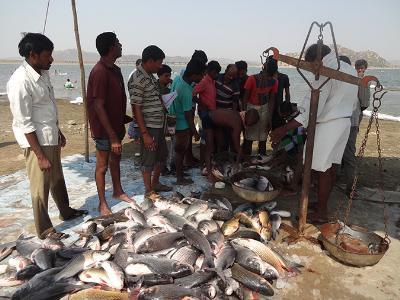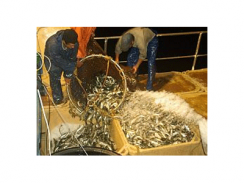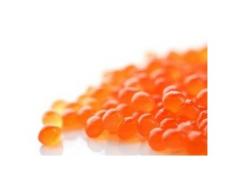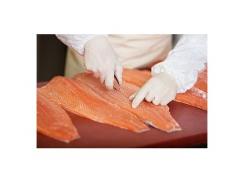Indias reservoirs show significant potential for aquaculture

Cage culture systems for fish production are being introduced
View of fish cultured and harvested in a reservoir being weighed.
The government of India generally classifies its water reservoirs as small (< 1,000 hectares), medium (1,000 to 5,000 ha) and large (> 5,000 ha). All man-made impoundments, created by erecting a dam of any description to obstruct the surface flow of a river, stream or any water course, have been classified as reservoirs. India has 19,134 small reservoirs with a total water surface area of 1,485,557 ha. Similarly, 180 medium and 56 large reservoirs of the country have an area of 527,541 and 1,140,268 ha, respectively. Thus, the country has a total of 19,370 water reservoirs covering an area of 3,153,366 ha, but with the constant addition of new reservoirs and impoundments, this significant area is likely to further increase in the coming years.
A reliable estimate of fish production from Indian reservoirs is currently not available. Compared with the impressive volume of data on various limnological aspects of reservoirs collected by various individual researchers and research institutions, the estimates for fish catches remain inadequate. Nevertheless, the average productivity from all categories of reservoirs is estimated at about 20 kg/ha/year, with the potential for a very significant increase, as has been demonstrated in some small, medium and large reservoirs in the country.
Fisheries management practices
In India, fisheries are under the control of individual states and there is much variation in this control, ranging from the outright auctioning to almost free-fishing in the management practices followed by different states. Cooperative societies and the state-level fisheries development corporations are also involved in fishing and marketing operations. The nature of their involvement and their role in fishery and market interventions often varies from one reservoir to another within the same state.
Reservoirs in India, with very few exceptions, are public water bodies owned by government departments such as those responsible for irrigation and power generation. In many cases the management of their fisheries is handed over to the fisheries departments.
Reservoir fishermen are among the weakest groups in Indian society and are heavily assisted by the government. Normally, the department of fisheries stocks the reservoirs with aquacultured fish free of charge, and offers various loans and subsidies to the fishers for the procurement of nets and boats. The amount of the subsidies and the nature and terms of the loans varies from state to state. The states are generally found to be quite liberal and fishing is made virtually free for all. This is one of the reasons why accurate statistics are about impossible to obtain.
In many cases, licenses are issued either free of cost or for a very small nominal fee for political reasons or because of other considerations. The development of reservoir fisheries is often linked to many social welfare and relief activities under the village and district administration. In such cases, immediate social goals are pursued, overlooking long-term interests and tenets of capture fishery norms.

Releasing fish fingerlings from hatchery into reservoir.
Reservoir stocking and its impacts
The stocking of reservoirs with young fish raised in hatcheries and nurseries is done by departments, except for those leased out to private fish farmers. All the states have nurseries to raise fish fingerlings for stocking their reservoirs. However, most of the reservoirs remain under-stocked because of the inability of departmental farms to produce the required number and species of fish fingerlings. Scientific norms are seldom followed in selecting the species for stocking. The policies previously adopted for Indian reservoirs emphasized mainly stocking fingerlings of a species or a combination of species, without taking into consideration aspects such as the density levels or ratios based on the biogenic capacity of the specific reservoirs. The fish species used and the stocking rates are often determined by fish availability.
The introduction of induced breeding of fish by the 1970s resulted in a shift in species-mix in favor of Indian carps, catla (Catla catla), rohu (Labeo rohita) and mrigal (Cirrhinus mrigala). Today, reservoir fisheries in India largely focus on the development of carp fisheries. The importance of their role has been demonstrated in the Gangetic as well as peninsular reservoirs.
Stocking has been much more effective in improving the yield from small reservoirs than in large and medium reservoirs. This is because the success in the management of small reservoirs depends more on recapturing the stocked fish than on their building up a breeding population. The smaller water bodies have the advantage of easy stock monitoring and manipulation. Thus, the smaller the reservoirs, the better the chances of success in the stock and recapture process. In fact, an imaginative stocking and harvesting schedule is the main concern of fisheries management in small, shallow reservoirs in India.

View of fish cages at the Chandil reservoir in Jharkand.
NFDB interventions
The National Fisheries Development Board (NFDB) was established in 2006 and with its headquarters at Hyderabad. Its goal is to understand the gaps, resources, potentials and constraints in the adoption of various activities and approaches devised for enhancement of fish production in the country. Reservoir fisheries development is one of the activities in its plan.
Guidelines have been developed by the NFDB for the benefit of the states to undertake and develop fisheries in reservoirs having an area of 40 ha or more and with minimum water retention periods of nine to 12 months. To augment the production of fish in reservoirs, the NFDB is supporting financial assistance and training for fisher folk concerned about stocking adequate numbers of carp fingerlings of the appropriate length (80-100 mm) and quality at the right time. These components support the development of fisheries in Indian reservoirs.
Cage culture systems for fish production have been introduced to some of the reservoirs in India for the development of fisheries. Now, pangasius and GIFT (genetically improved farmed tilapia) are being cultured mainly in these cage culture systems in reservoirs, and the results are also encouraging for further development.

Fishermen and their catch at a reservoir in India.
Perspectives
Poor appreciation of the biological and limnological functions controlling the production regimes of reservoirs as well as the lack of stocking programs have resulted in sub-optimal utilization of the fisheries potential of the reservoirs in India. Through a series of efforts – including the sustained, supplementary stocking of quality fingerlings, augmenting the fish stocks through auto stocking, adoption of appropriate mesh sizes, optimum fishing effort and enforcement of closed areas and closed seasons – it is expected that the average productivity could be increased to a level of 500 kg/ha/yr. for small reservoirs; 200 kg/ ha/yr. for medium reservoirs, and 100-150 kg/ha/yr. from the large reservoirs.
The best management practices evolved over the years for various types of reservoirs involve “stocking-cum-capture practices” for large and medium reservoirs, and “put and take practices” for small reservoirs.
However, the success of these management practices would necessitate formulation of appropriate reservoir policies by the state governments, which should take into consideration the intended beneficiaries. These include the socio-economic benefits that would accrue to the beneficiaries, especially the poorest sectors of society; human resource development; fisheries management rights; conservation and protection of breeding areas; lease policies, and others.
Overall, Indian reservoirs have significant potential to very significantly increase yields for fisheries and aquaculture.
Dr. B. Laxmappa, M.Sc., Ph.D.
- Fisheries Development Officer
- Department of Fisheries
- Mahabubnagar – 509 001
- Telangana, India
Related news
Tools

Phối trộn thức ăn chăn nuôi

Pha dung dịch thủy canh

Định mức cho tôm ăn

Phối trộn phân bón NPK

Xác định tỷ lệ tôm sống

Chuyển đổi đơn vị phân bón

Xác định công suất sục khí

Chuyển đổi đơn vị tôm

Tính diện tích nhà kính

Tính thể tích ao




 Argentina’s cut to Patagonian export subsidies upsets shrimp…
Argentina’s cut to Patagonian export subsidies upsets shrimp…  Polish Fish Processor Plans Huge Expansion
Polish Fish Processor Plans Huge Expansion